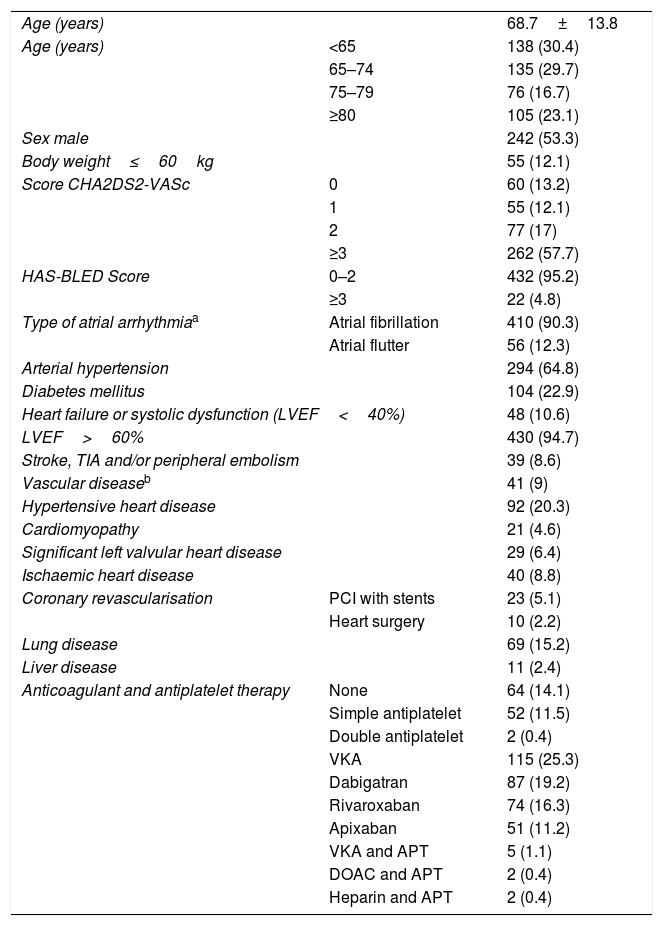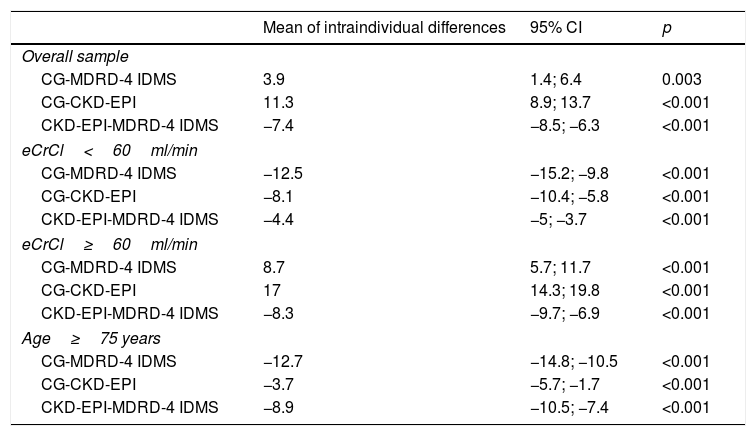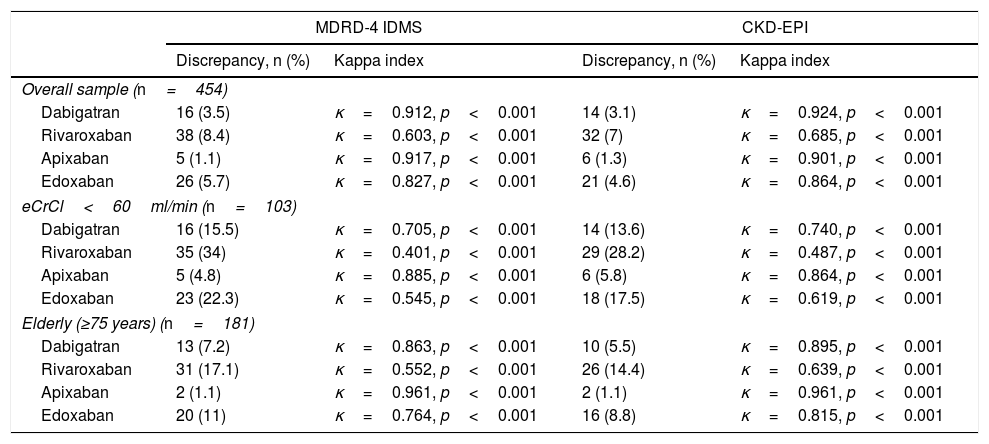Direct oral anticoagulants (DOACs) require dose adjustment according to estimated clearance creatinine (eClCr) using the Cockcroft–Gault (CG) equation. There are discrepancies with the equations that estimate glomerular filtration rate (eGFR). We analyse how the use of the CKD-EPI and MDRD-4 IDMS equations affect the recommended dosage for ACODs.
Patients and methodsRetrospective study of patients with non-valvular atrial fibrillation seen at a cardiology clinic between November 2012 and August 2014. Patients were reclassified according to the recommended dosage for dabigatran, rivaroxaban, apixaban and edoxaban, based on the eGFR equation used. Other clinical factors are taken into account, according to the product label. We analysed the percentage of discordance.
ResultsFour hundred and fifty-four patients, 53.3% men, with a mean age of 68.7±13.8 years were studied. The mean intra-individual differences recorded for the CG equation were 3.9ml/min/1.73m2 with MDRD-4 IDMS (95% CI 1.4–6.4, p=0.003) and 11.3ml/min/1.73m2 with CKD-EPI (95% CI 8.9–13.7, p<0.001). A gradient is observed in the discordance of the posology (apixaban 1.1%, dabigatran 3.5%, edoxaban 5.7%, rivaroxaban 8.4% with MDRD-4 IDMS). Differences were limited to patients with eClCr<60ml/min and were more evident in ≥75 years in which the eGFR equations overestimate renal function.
ConclusionsIn patients with non-valvular atrial fibrillation, especially with renal failure and in the elderly, eGFR equations tend to overestimate renal function relative to CG and therefore suggest an overdose of DOACs.
Los anticoagulantes orales directos (ACOD) precisan ajuste de dosis según el estimated clearance creatinine (eClCr, «aclaramiento de creatinina estimado») por la ecuación de Cockcroft-Gault (CG). Existen discrepancias entre las ecuaciones que estiman el filtrado glomerular (FGe). Analizamos cómo afecta a la posología recomendada para los ACOD el empleo de las ecuaciones CKD-EPI y MDRD-4 IDMS.
Pacientes y métodosEstudio retrospectivo de pacientes con fibrilación auricular no valvular atendidos en una consulta de cardiología entre noviembre de 2012 y agosto de 2014. Se reclasifican los pacientes según la posología recomendada para dabigatrán, rivaroxabán, apixabán y edoxabán en función de la ecuación de FGe empleada. Se tienen en cuenta otros factores clínicos, según ficha técnica. Analizamos el porcentaje de discordancia.
ResultadosSe estudian 454 pacientes, 53,3% hombres, con una edad media de 68,7±13,8 años. La media de las diferencias intraindividuales registradas respecto a la ecuación de GC fue de 3,9ml/min/1,73m2 con MDRD-4 IDMS (IC 95% 1,4-6,4; p=0,003) y 11,3ml/min/1,73m2 con CKD-EPI (IC 95% 8,9-13,7; p<0,001). Se observa un gradiente en la discordancia de la posología (apixabán 1,1%, dabigatrán 3,5%, edoxabán 5,7%, rivaroxabán 8,4% con MDRD-4 IDMS). Las diferencias se limitaron a los pacientes con eClCr<60ml/min y fueron más manifiestas en≥75 años, en los que las ecuaciones de FGe sobreestiman la función renal.
ConclusionesEn pacientes con fibrilación auricular no valvular, especialmente con insuficiencia renal y en ancianos, las ecuaciones de FGe tienden a sobreestimar la función renal respecto a CG y, por ello, a recomendar una sobredosificación de los ACOD.
Artículo
Comprando el artículo el PDF del mismo podrá ser descargado
Precio 19,34 €
Comprar ahora












